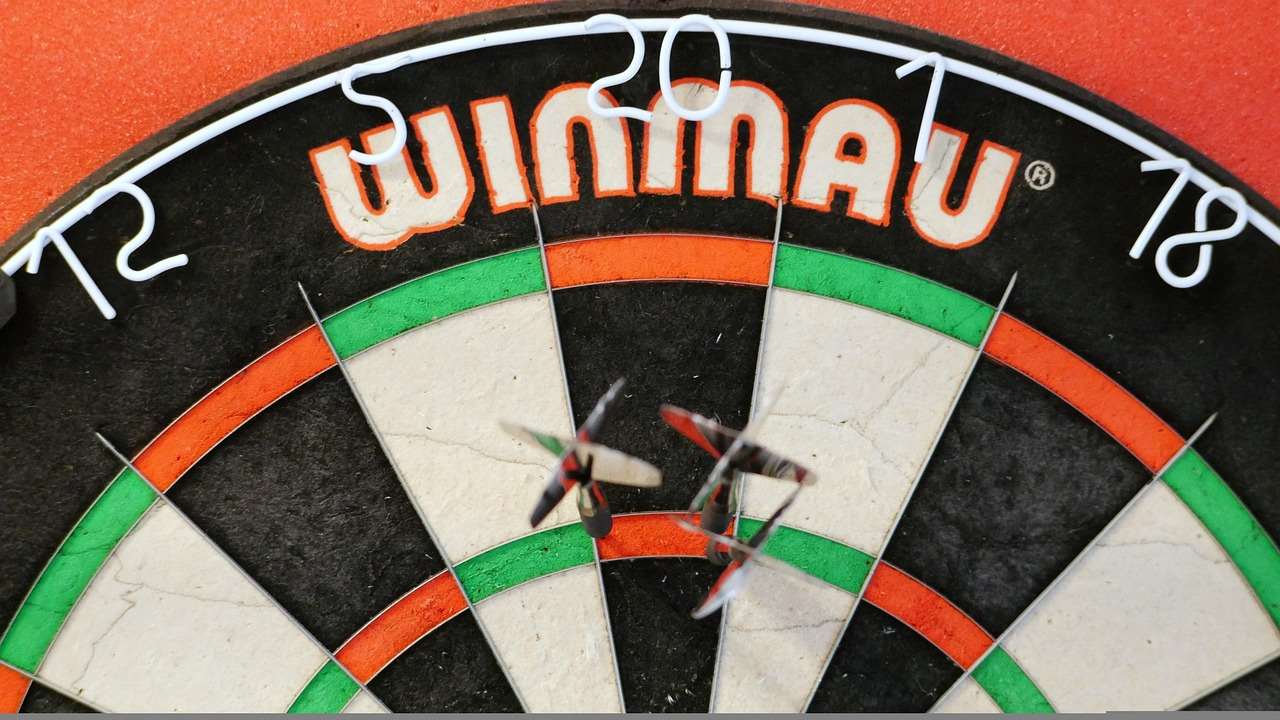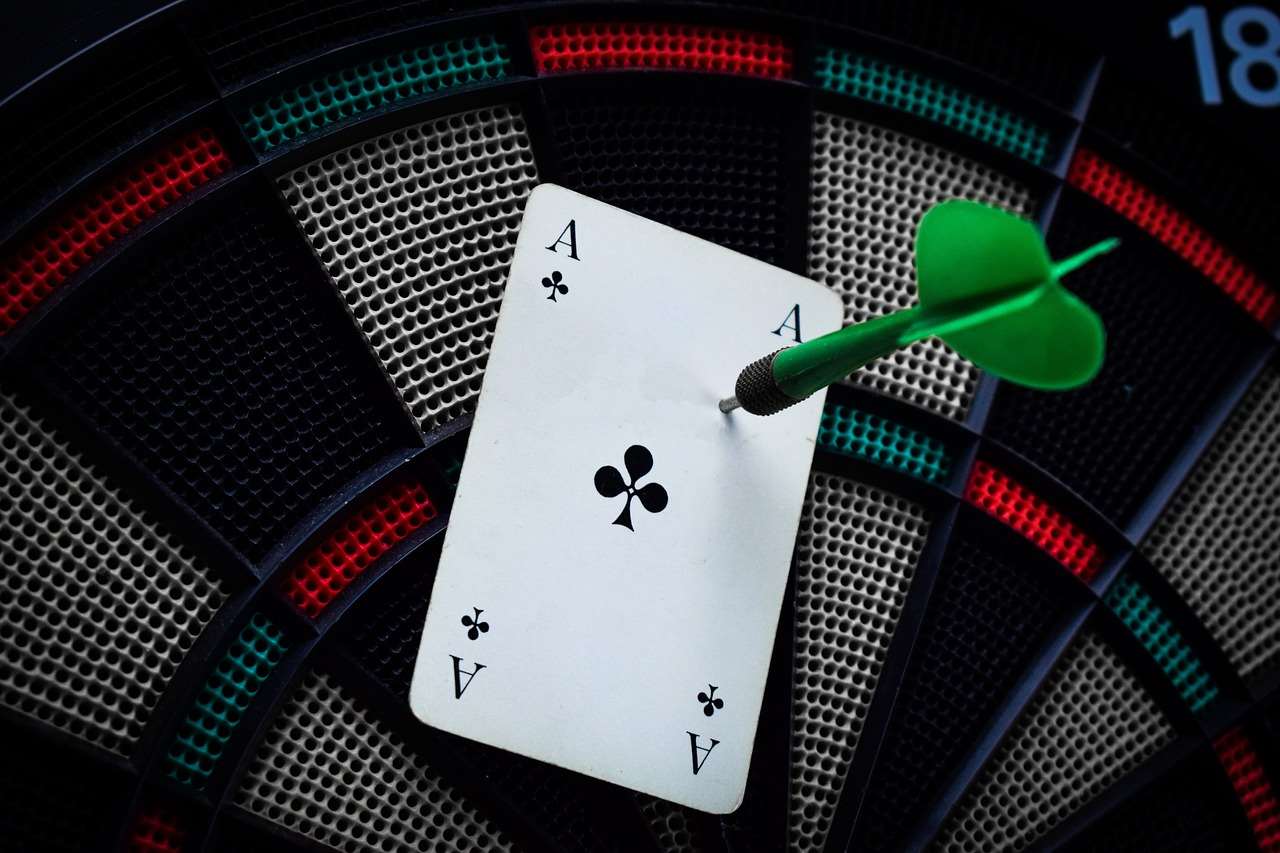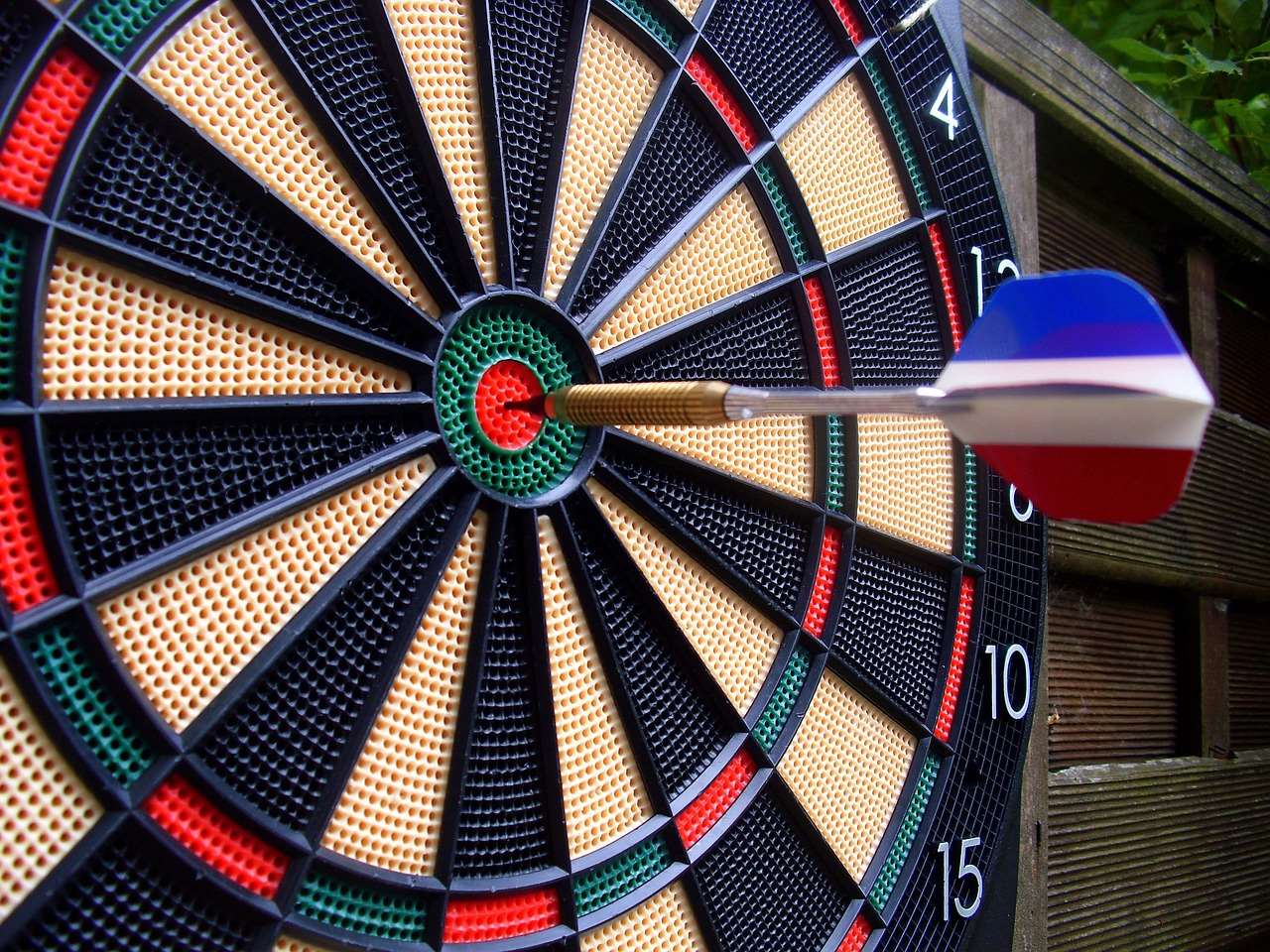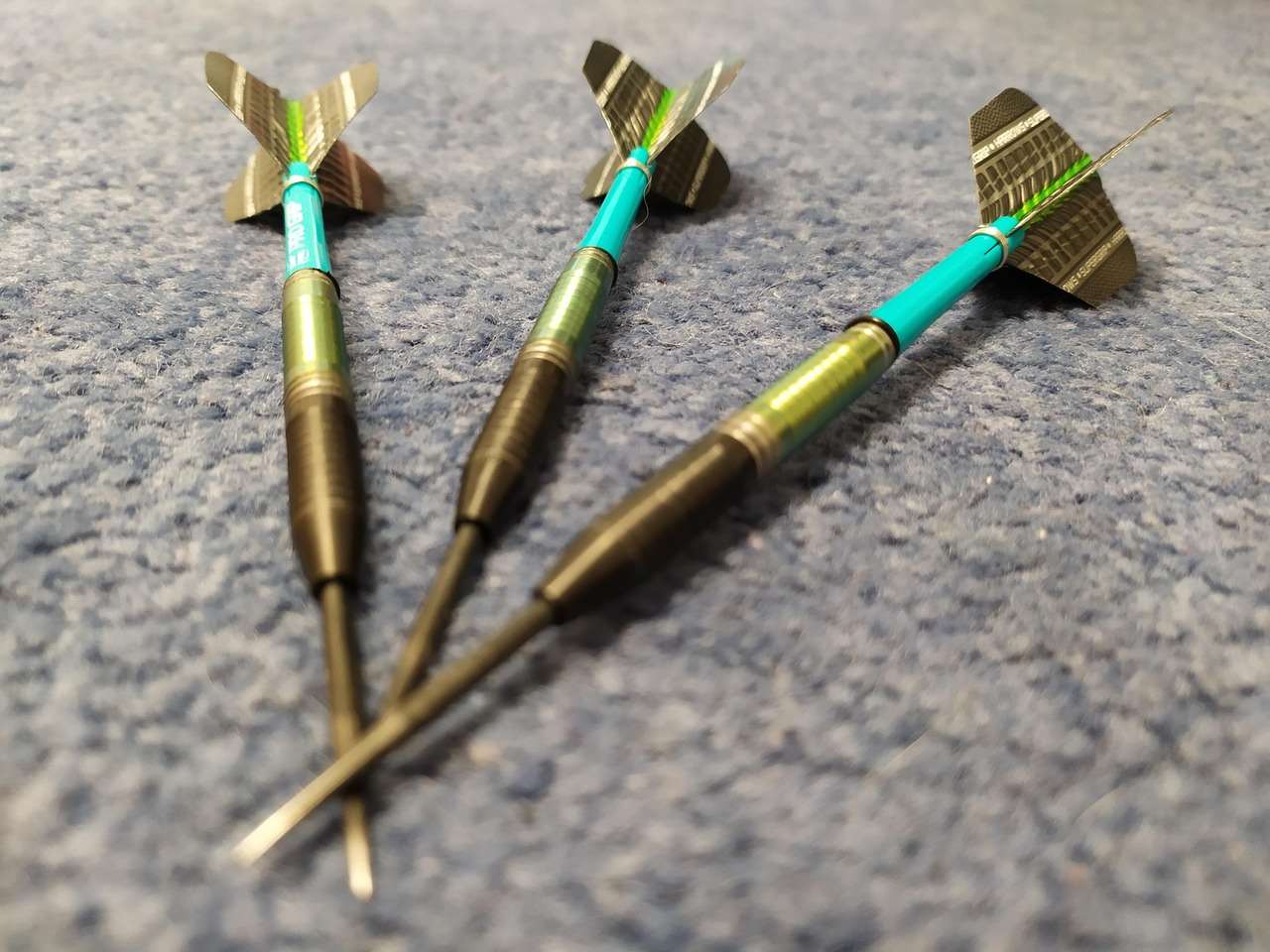Understanding the **darts terms: ‘Bullseye’, ‘Inner Bull’, and ‘Outer Bull’** is crucial for anyone wanting to seriously engage with the sport, whether as a player or a spectator. This article breaks down the specific scoring, visual identification, and strategic importance of each target, providing you with a comprehensive understanding to improve your game and appreciation for darts.
⚠️ Still Using Pen & Paper (or a Chalkboard)?! ⚠️
Step into the future! The Dart Counter App handles all the scoring, suggests checkouts, and tracks your stats automatically. It's easier than you think!
Try the Smart Dart Counter App FREE!Ready for an upgrade? Click above!
Understanding the Darts Board: Focusing on ‘Bullseye’, ‘Inner Bull’, ‘Outer Bull’
The dartboard, a seemingly simple circular target, holds a world of strategy and precision. To truly appreciate the game of darts, you must first understand the anatomy of the board, especially those central rings: the **’Bullseye’, ‘Inner Bull’ (often called the ‘Double Bull’), and ‘Outer Bull’ (sometimes referred to as the ‘Single Bull’)**. Each of these sections has a different point value and, therefore, demands a different approach. We’ll explore each one in detail.

The General Layout
Before we dive into the bullseye variations, let’s briefly recap the standard dartboard layout. The board is divided into 20 numbered sections, each separated by wires. Around the outer edge is the double ring, scoring double the value of the number it lands on. Inside that is the treble ring, scoring triple the number. The rest of the board is divided into single-score areas. Mastering the basic darts fundamentals for beginners will help you understand the board and target the areas you need to win.
What is the Outer Bull (Single Bull)?
The **Outer Bull** is the larger, green ring surrounding the smaller, red center. Hitting the **Outer Bull** scores 25 points. It’s often the easiest of the bullseye targets to hit, making it a popular starting point for beginners and a useful safety net for more advanced players.
Strategic Importance of the Outer Bull
While it might not seem as glamorous as hitting the **Inner Bull**, the **Outer Bull** has its place in a dart player’s strategy. Consider these scenarios:
- Rounding Out Scores: If you need to reduce your score to a number ending in 25, hitting the **Outer Bull** is the perfect solution.
- Saving a Busted Turn: If your first two darts are off target and risk busting your score (reducing it to below zero or one), aiming for the **Outer Bull** can be a safe option to salvage the turn and stay in the game.
- Setting Up a Finish: The **Outer Bull** can be used strategically to set up a double out finish in games like 501.
The ‘Inner Bull’ (Double Bull or Bullseye): The Heart of the Matter
Now we come to the centerpiece: the **Inner Bull**, often referred to as the **Bullseye** (though technically the entire central area, including the Outer Bull, can be called the Bullseye). This is the small, red circle in the very center of the dartboard. A direct hit on the **Inner Bull** earns you a whopping 50 points – the highest single score possible with one dart.
Why is Hitting the Inner Bull so Valuable?
Aside from the high point value, the **Inner Bull** holds a psychological advantage. Successfully hitting it demonstrates accuracy and control, potentially intimidating your opponent. The simplified 501 game rules for novice players highlight the importance of scoring big, and nothing does that quite like hitting the double bull.
Here’s a breakdown of why the **Inner Bull** is so coveted:
- High Score: Provides a significant boost to your score, especially in games like 501.
- Checkout Potential: Crucial for finishing the game, especially when needing to leave a score of 50 or less.
- Psychological Impact: Boosts your confidence and potentially rattles your opponent.

Techniques for Targeting the Inner Bull
Hitting the **Inner Bull** consistently requires practice, focus, and proper technique. Here are some tips:
- Stance: Maintain a consistent and balanced stance. Find what works best for you and stick with it.
- Grip: Experiment with different grips to find one that provides control and comfort.
- Aiming: Focus intently on the **Inner Bull** before each throw. Visualize the dart hitting the target.
- Release: Ensure a smooth and consistent release. Avoid jerky movements.
- Follow Through: Complete your throwing motion fully. Don’t stop short.
- Practice: The most important factor! Consistent practice builds muscle memory and improves accuracy.
The Bullseye Debate: Inner Bull vs. Outer Bull
As mentioned earlier, the term **’Bullseye’** can be confusing. Technically, it refers to the entire central area encompassing both the **Inner Bull** (50 points) and the **Outer Bull** (25 points). However, in common usage, especially among experienced players, **’Bullseye’** often specifically refers to the **Inner Bull**. When clarity is needed, it’s best to specify **’Inner Bull’** or **’Outer Bull’** to avoid ambiguity.
Why the Confusion?
The ambiguity likely stems from the fact that the **Inner Bull** is the more desirable and impactful target. Calling it the **’Bullseye’** emphasizes its importance. The **Outer Bull**, while still part of the overall “bullseye” area, is often distinguished by its lower point value and different strategic role.
Advanced Strategies Involving the ‘Bullseye’, ‘Inner Bull’, and ‘Outer Bull’
Beyond basic scoring, understanding the nuances of the **’Bullseye’, ‘Inner Bull’, and ‘Outer Bull’** is key to developing advanced strategies. For example, in games like 501, expert players will often deliberately leave themselves a score that can be finished with a combination of a treble and a **Bullseye** (Inner Bull), or two **Inner Bulls**, for a quick and decisive victory. Knowing the fun dart game variations with modified rules can also help you think creatively about using these targets.
Utilizing the Bull for Checkouts
The **Inner Bull** is a valuable tool for checking out, especially when you have a score of 50 left. If you can reliably hit the **Inner Bull**, you can often win the leg in a single throw. However, it’s important to consider the risk. If you miss the **Inner Bull**, you could leave yourself with a difficult score. Therefore, it’s often wise to only attempt the **Inner Bull** checkout if you are confident in your ability or if the pressure is on and you need to take a risk.

Defensive Play: Using the Outer Bull Strategically
The **Outer Bull**, although worth fewer points, can be a valuable defensive tool. For example, if your opponent is close to finishing and you need to score points quickly to catch up, but are not confident in hitting a high treble, targeting the **Outer Bull** can be a safe and reliable way to add 25 points to your score. This can put pressure on your opponent and potentially force them to make a mistake.
Practice Drills to Improve Your Bullseye Accuracy
To truly master the **’Bullseye’, ‘Inner Bull’, and ‘Outer Bull’**, you need to dedicate time to practice. Here are some effective drills:
- Bullseye Challenge: Throw 20 darts, aiming only for the **Inner Bull**. Record your score. Repeat daily and track your progress.
- 25 or 50 Drill: Alternate between aiming for the **Outer Bull** (25) and the **Inner Bull** (50). This helps you develop accuracy for both targets.
- Checkout Simulation: Start with a score of 100 and try to check out using combinations involving the **Inner Bull**. Vary your approach to simulate different game scenarios.
- Around the Clock Bull: Start by aiming for the 1 segment, then 2, then 3, and so on, going around the board, always finishing with a dart at the bullseye each round.

Beyond the Basics: Advanced ‘Darts terms: ‘Bullseye’, ‘Inner Bull’, ‘Outer Bull” Considerations
Even experienced players can refine their understanding of **Darts terms: ‘Bullseye’, ‘Inner Bull’, and ‘Outer Bull’**. Factors like dart weight, shaft length, and flight shape can all influence dart trajectory and impact accuracy when targeting these crucial areas. Additionally, mental focus and the ability to handle pressure are paramount, especially when attempting a **Bullseye** checkout in a competitive match. Learning how to make darts fairer with handicap rules can also make practice sessions more engaging.
The Impact of Dart Setup on Bullseye Accuracy
Experiment with different dart setups to find what works best for you. Heavier darts tend to be more stable in the air, while lighter darts can be easier to control. Shorter shafts can improve accuracy for some players, while longer shafts can provide more stability. Flight shape also plays a role. Larger flights provide more drag and can help to stabilize the dart, while smaller flights offer less drag and can allow for a faster, more direct trajectory towards the **Inner Bull**.
Conclusion: Mastering the Bull for Darting Success
In conclusion, a thorough understanding of the **darts terms: ‘Bullseye’, ‘Inner Bull’, and ‘Outer Bull’** is fundamental to becoming a proficient darts player. From understanding their specific scoring values to developing strategies for their optimal use, each element contributes to a player’s overall success. By practicing regularly, experimenting with different techniques, and continuously refining your approach, you can improve your accuracy and elevate your game. So, grab your darts, aim for the center, and start your journey to becoming a **Bullseye** master! Now that you understand the board better, go practice and see if you can improve your scores!
Hi, I’m Dieter, and I created Dartcounter (Dartcounterapp.com). My motivation wasn’t being a darts expert – quite the opposite! When I first started playing, I loved the game but found keeping accurate scores and tracking stats difficult and distracting.
I figured I couldn’t be the only one struggling with this. So, I decided to build a solution: an easy-to-use application that everyone, no matter their experience level, could use to manage scoring effortlessly.
My goal for Dartcounter was simple: let the app handle the numbers – the scoring, the averages, the stats, even checkout suggestions – so players could focus purely on their throw and enjoying the game. It began as a way to solve my own beginner’s problem, and I’m thrilled it has grown into a helpful tool for the wider darts community.